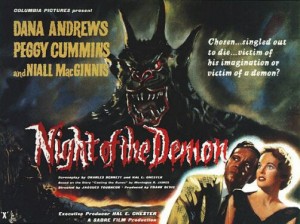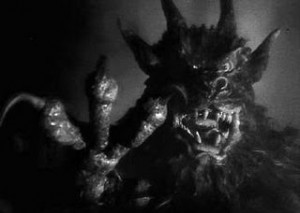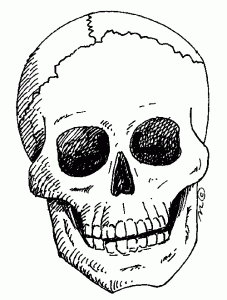 Night of the Demon (1957), the last of these horrible old movies, just happens to be the best of the five. The good music continues—less nineteenth century, less luscious than Moonfleet—but now stark, angular and thinly textured. Clifton Parker, who scored Sink the Bismarck! and—small world (again)!—Disney’s Treasure Island, renders a near-perfect score for Demon, sometimes confusingly known as Curse of the Demon and extant in several edited/expanded versions. The main title music, behind views of Stonehenge, opens with an ominous voice-over, intoning the conjuring of demons from hell. The music, which at times suggests the first movement of Vaughan Williams’ Sixth Symphony, segues unbroken into a car racing through the night, down an English country road, the headlights illuminating the passing trees.
Night of the Demon (1957), the last of these horrible old movies, just happens to be the best of the five. The good music continues—less nineteenth century, less luscious than Moonfleet—but now stark, angular and thinly textured. Clifton Parker, who scored Sink the Bismarck! and—small world (again)!—Disney’s Treasure Island, renders a near-perfect score for Demon, sometimes confusingly known as Curse of the Demon and extant in several edited/expanded versions. The main title music, behind views of Stonehenge, opens with an ominous voice-over, intoning the conjuring of demons from hell. The music, which at times suggests the first movement of Vaughan Williams’ Sixth Symphony, segues unbroken into a car racing through the night, down an English country road, the headlights illuminating the passing trees.
Although some of the film’s edge is dulled by a lackluster female lead, Peggy Cummins (Joanna), and a stoic Dana Andrews as American paranormal psychologist Dr. John Holden, these negatives are more than offset by the dominance of Niall MacGinnis as Julian Karswell, the intelligent leader of an occult group and part-time magician. Under the guise of friendly assistance, Karswell covertly slips to Holden a parchment of runic symbols which forecasts that, on a prescribed date, an ancient Druid-type demon will bring him to an horrific end.
Through a realistic, expert script by Charles Bennett and Cy Endfield, Karswell later warns Holden about the portent of the curse:
“But as the time gets closer, mental disintegration will set in, first weakness and unsureness, and then horror as the fear of what is behind you grips your heart. Because it’s there, Doctor Holden, it’s there. It has been from the moment we met in the museum.”—when he slipped him the parchment.
 With minor roles in Becket (as one of the three knights who slays archbishop Richard Burton) and in Billy Budd (as Captain Graveling), MacGinnis, despite doting over his indulgent mother and hosting a kid’s Halloween party, is at other times calmly and subtly menacing. The contrasting demeanors remain totally convincing, a triumph of under acting. At the climax of a long, rational conversation between Karswell and Holden, Karswell conjures up a storm (one of the best scenes in the film), which causes havoc at the children’s party, reminiscent of the bird attacks at another children’s party, in Alfred Hitchcock’s The Birds.
With minor roles in Becket (as one of the three knights who slays archbishop Richard Burton) and in Billy Budd (as Captain Graveling), MacGinnis, despite doting over his indulgent mother and hosting a kid’s Halloween party, is at other times calmly and subtly menacing. The contrasting demeanors remain totally convincing, a triumph of under acting. At the climax of a long, rational conversation between Karswell and Holden, Karswell conjures up a storm (one of the best scenes in the film), which causes havoc at the children’s party, reminiscent of the bird attacks at another children’s party, in Alfred Hitchcock’s The Birds.
“I didn’t know you had cyclones in England,” Holden comments after the two have sought refuge in the country estate—the prerequisite old house.
“We don’t,” Karswell replies.
Although the tempo is sometimes slow, the suspense and interest rarely waver. Holden’s visit to the family of a psychotic victim of the demon, however, is somewhat confusing, distracting and unnecessary. It is compensated by comic relief at a séance, conducted by a phony medium, Mr. Meek (Reginald Beckwith). Mrs. Meek and lady friends accompany a phonograph in “Cherry Ripe,” an old English song which “the spirits like.” When Holden, who has had enough of the chicanery, interrupts the trance, Mr. Meek says, “I feel sick!” And Holden replies, “You’re not the only one.”
Director Jacques Tourneur—that’s right, of Cat People and Out of the Past fame—never intended that the demon should be seen, but Columbia executives decided otherwise, possibly figuring that an audience wouldn’t have enough imagination to envision one, or that the script wasn’t strong enough on its own, which it clearly is. Showing the demon in the first ten minutes spoils the suspense, though, admitted, it is most impressive when later materializing as smoke, then a ball of fire, among the trees. Holden is returning through the woods to his car after his break-in at Karswell’s estate, despite Karswell’s suggestion he would be wiser to leave by the front door.
The exciting climax occurs on a train, Karswell in flight and Holden in pursuit. Holden must return the parchment to Karswell and thus transfer the curse to the giver, for whoever has the runic symbols at the crucial time will be incinerated. Onlookers at the station suggest Karswell was killed by another train passing on an adjacent track. Joanna says, “Maybe it’s best not to know,” and Holden agrees. Rather than another graphic depiction, an unseen demon would have been more effective, the viewer left with uneasy doubts and the film left open-ended. Was it the fiend or not?
Point of interest: Athene Seyler, who plays Karswell’s protective mother, was better known as a stage actress specializing in Shakespeare and Shaw.
As the Emperor said in Amadeus, “There you have it.” Five movies in order of preference. While the first film, Night Monster, is critically and esthetically the weakest and the last, Night of the Demon, the greatest, the order of quality for the in-between three was disrupted. Chronological order would have been one approach, except that would have blunted the contrasts and ended anticlimactically. Oh, well!
There’re other horrible old movies I like as well or better than some of these—The Bride of Frankenstein, the 1947 version of The Spiral Staircase, The Invisible Man and Psycho—but the five discussed are sentimental favorites, imbued by memories of my youth and that first-viewing experience. Most essential in meeting my criteria, they are ideally suited for seeing over and over, delicious addictions, much as my one and only “junk” food craving, Tom’s Hot Fries.
.

you are right about moonfleet but you are all F-up about the others as they are classics and will be here long after you